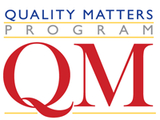Establish a connected foundation for student learning
Learning objectives are the heart of the Quality Matters Rubric, establishing a foundation upon which the rest of hybrid or online course is based. Everything in a hybrid or online course -- from the module objectives to instructional materials and activities, and even the technologies and tools -- must consistently support the course learning objectives.
General Standard 2 for Learning Objectives looks for measurable learning objectives at the course and unit level, which will help your students know what they will need to do to successfully complete the course. A unit can be defined in multiple ways such as a week or module, and these are typically described in specific, observable terms and in smaller, discrete pieces. For example, here is a course objective for a freshman writing course with three unit-level objectives:
Course Objective:
Upon completion of this course, learners will demonstrate mastery of rules of punctuation.
Unit-Level Objectives:
Learners will write sentences that demonstrate correct use of commas, semicolons, and periods.
Learners will use apostrophes when, and only when, needed.
Learners will use double and single quotation marks correctly in quoted material.
Learning objectives should be appropriate for the course level, written with the student in mind, and consistently linked to course activities. Bloom’s Taxonomy is very helpful to ensure appropriate learning objectives, and many instructors use a numbering system to show how the learning objectives align to course activities.
All five elements in this standard are essential and other QM standards evaluate the success of course and unit-level learning objectives. Alignment, therefore, is critical to support General Standard 2. Alignment emphasizes the idea that certain critical course components (course materials, assessments, learning activities, and tools) will work together to ensure that students achieve the desired learning outcomes for your course.
If you think of a house, then the learning objectives form the foundation and structure of the course and its modules. The materials, activities, opportunities for engagement and interaction, the tools used -- all of that infrastructure supports and enhances the learning objectives, and ensures a deep, meaningful connection to the assessments, which are used to evaluate the objectives of the course or modules.
For more information about Quality Matters and Instructional Technology at UMBC:
Follow our Instructional Technology group page
Visit our FAQ collection
Open an RT ticket
Request an appointment with an instructional technology specialist
The Faculty Development Center provides workshops and consulting opportunities for faculty to develop or improve their learning objectives.
Next month, we’ll look at General Standard 3: Assessments.
Posted: October 4, 2016, 3:00 PM
